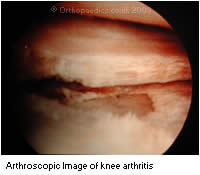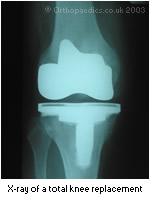


Bristol Knee Clinic

| + home | |
| + news | |
| + research | |
| + patient information | |
| + the clinic | |
| + the surgeon | |
| + sport physiotherapy | |
| + sports advice | |
| + medico legal | |
| + products | |
| + resources | |
| + contact | |
| + maps | |
| + directions | |
| + site map |
The Bristol Knee Clinic |
Total Knee Arthroplasty - TKR - Introduction
What is Total Knee Replacement (Arthroplasty)
 Total knee arthroplasty is undertaken for knee arthritis. With age or following rheumatoid arthritis the
weight bearing surfaces of the knee joint become worn away. They are no longer smooth and free running and
this leads to stiffness and pain. Eventually the joint wears away to such an extent that the bone of the
femur grinds on the bone of the tibia. Joint replacement is then required. New technology, new techniques
and new types of knee replacements have made this procedure in recent years very successful and the results
are now as good or better than hip replacement.
Total knee arthroplasty is undertaken for knee arthritis. With age or following rheumatoid arthritis the
weight bearing surfaces of the knee joint become worn away. They are no longer smooth and free running and
this leads to stiffness and pain. Eventually the joint wears away to such an extent that the bone of the
femur grinds on the bone of the tibia. Joint replacement is then required. New technology, new techniques
and new types of knee replacements have made this procedure in recent years very successful and the results
are now as good or better than hip replacement.
When the arthritis is severe in one compartment, in a younger patient (under 65) only the damaged half of the knee may be removed and replaced; a unicompartmental knee replacement. Alternately just the patella-femoral joint may be affected and a patella-femoral knee replacement may be appropriate. The surgery and post-operative treatment and recovery might be more rapid than for total knee replacement. When the arthritis is severe effecting all compartments, or in the presence of rheumatoid arthritis or in older patients, the whole knee joint is removed and replaced. In very special cases knee replacement may be used in younger patients when a special type of knee replacement will be used, possibly without the use of cement.
 A total knee replacement replaces the surfaces of the knee with plastic and metal components. The femoral
replacement is a smooth metal component which fits snugly over the end of the bone. The tibial replacement
is in two parts, a metal base plate sitting on the bone and a plastic insert which sits between the metal
base on the tibial and the femoral component. If necessary the patella surface (under the knee cap) is
replaced with a plastic button which glides over the metal surface of the femoral replacement. However, the
patella is occasionally satisfactory and may not require replacement.
A total knee replacement replaces the surfaces of the knee with plastic and metal components. The femoral
replacement is a smooth metal component which fits snugly over the end of the bone. The tibial replacement
is in two parts, a metal base plate sitting on the bone and a plastic insert which sits between the metal
base on the tibial and the femoral component. If necessary the patella surface (under the knee cap) is
replaced with a plastic button which glides over the metal surface of the femoral replacement. However, the
patella is occasionally satisfactory and may not require replacement.
The components are usually cemented to the bones in order to secure fixation. In certain circumstances special components may be "press fitted" to the bones without the additional use of cement. These components use micro-porous metallic surfaces and may have an additional hydroxyapatite coating to promote osteo-integration or bonding to the bone. These techniques may be considered and appropriate for younger patients.
< BACK to Total Knee Replacement Index | NEXT: Indications / Contra - indications >
Related Links..
+ How to make an appointment
+ Total Knee Replacement - see all links
+ Patient Information Home
+ See the clinic
+ More about Mr Johnson
+ top
© The Bristol Orthopaedics and Sports Injuries Clinic 2003. The Bristol Knee Clinic is a trading name of the Bristol Orthopaedic Clinic Ltd. privacy / copyright | contact | Powered By Create Medical



